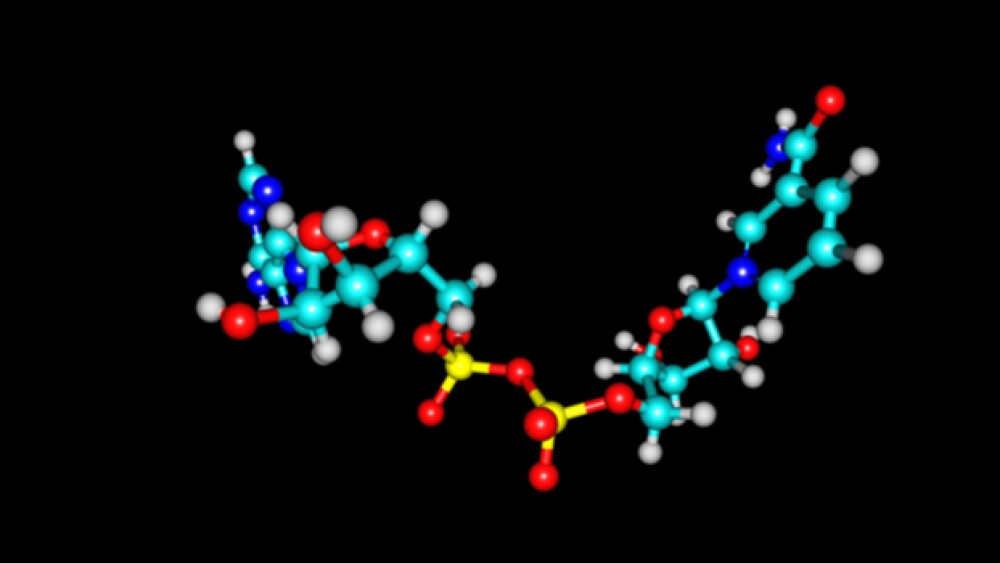There has been recent optimism—and possibly hype—over so-called NAD boosters. Kaiser Health News (KHN) recently reported on Harvard University researcher David Sinclair, who is taking his own research product, a supplement that boosts nicotinamide adenine dinucleotide (NAD), a cofactor found in all living cells.
Nicotinamide adenine dinucleotide (NAD).
There has been recent optimism—and possibly hype—over so-called NAD boosters. Kaiser Health News (KHN) recently reported on Harvard University researcher David Sinclair, who is taking his own research product, a supplement that boosts nicotinamide adenine dinucleotide (NAD), a cofactor found in all living cells.
NAD is involved with several enzymes that let cells release energy by way of the mitochondria, the energy producers in cells. It is also involved in DNA repair and other biochemical functions. And there’s little doubt that as we age, NAD levels decrease, as does mitochondrial function.
So compounds that boost NAD are under investigation for a range of ailments, including aging and Alzheimer’s disease.
Sinclair has significant financial incentives to push these supplements. He is an inventor on a patent licensed to Elysium Health, a company that sells a NAD booster in pills for $60 per bottle. He’s an investor in InsideTracker, a company that supposedly measured his age, claiming he was 20 years younger than his 49 years. In 2004, he co-founded Sirtris to test resveratrol’s benefits and at that time told the journal Science it was “as close to a miraculous molecule as you can find.” Resveratrol is an ingredient in red wine that might have anti-aging properties.
GlaxoSmithKline bought Sirtris in 2008 for $720 million. But it halted the research in 2010 because of unconvincing efficacy and potential side effects.
Sinclair takes resveratrol, the diabetes medicine metformin, which shows some indications of slowing aging, and nicotinamide mononucleotide (NMN), which has shown in mouse studies to increase energy and decrease aging.
Sinclair is also listed as either a founder, an investor, an equity holder, a consultant or a board member of 28 companies. And at least 18 of those are involved in anti-aging at some level. One of his companies, MetroBiotech, filed a patent related to nicotinamide mononucleotide. It’s not that his enthusiasm or faith in NAD boosters is misplaced or wrong, but there are certainly financial incentives for him to say they’re doing great things for him.
There’s little doubt that researching the role of NAD boosters is worthwhile. BioSpace recently interviewed Rudy Tanzi, Chair of the Cure Alzheimer’s Fund Research Leadership Group and the Kennedy Professor of Neurology at Harvard University and at Massachusetts General Hospital, as well as Rob Fried, chief executive officer of ChromaDex. Tanzi is both a shareholder and a member of ChromaDex’s Scientific Advisory Board.
ChromaDex manufactures Niagen (nicotinamide riboside or NR), a member of the vitamin B3 family. Cells in the body use NR to create NAD+.
There are currently four published clinical trials involving Niagen with 28 listed on clinicaltrials.gov. Most of the trials are in the neurological field, with some in cardiovascular, and others addressing obesity.
The brain is very energy-dependent. When the mitochondria age and stop using fuel like ATP, they are believed to become vulnerable. Microglial cells are specialized immune cells found in the central nervous system (CNS). They remove damaged cells and debris, like amyloid, to maintain the health of the CNS. But they also fight infections and react to neuronal cell death by triggering neuroinflammation. This leads to massive neuronal cell death, essentially via “friendly fire.” Tanzi told BioSpace, “A microglial cell is more likely to be neuroinflammatory if it is lacking in energy and, thus, less resilient.”
He went on to cite a study published in the journal Cell describing increasing ATP levels in a microglial cell that carried a mutant version of one of the Alzheimer’s genes known as TREM2. If you increased ATP levels, the microglial cell does a better job of clearing beta-amyloid, with the result of being less likely to become neuroinflammatory. “So when we talk about resilience of cells, it’s often about how much energy the cell has. As we get older, we have less cellular energy which has a lot to do with ATP and mitochondria. NAD levels drop as we get older, so if you supplement it, levels go back up, which starts to restore cellular energy, which has implications for Alzheimer’s disease and neurocellular resilience.”
But well-designed clinical trials in humans following preclinical animal studies are two different things—and very different from trying it on yourself, as Sinclair appears to be doing. As KHN writes, “Human metabolism is different from that of rodents. And our existence is unlike a mouse’s life in a cage. What is theoretically possible in the future remains unproven in humans and not ready for sale, experts say.”
Felipe Sierra, director of the division of aging biology at the National Institute on Aging at the National Institutes of Health (NIH), told KHN, “None of this is ready for prime time. The bottom line is I don’t try any of these things. Why don’t I? Because I’m not a mouse.”





